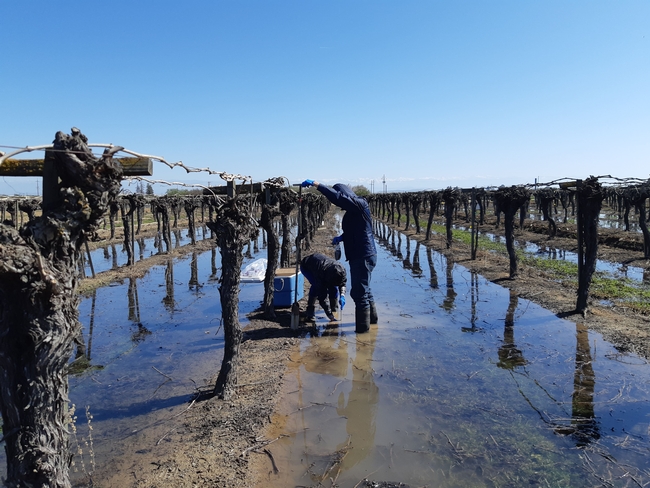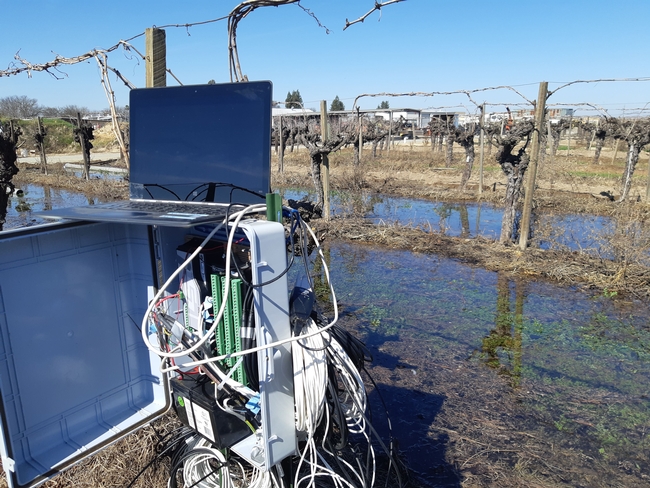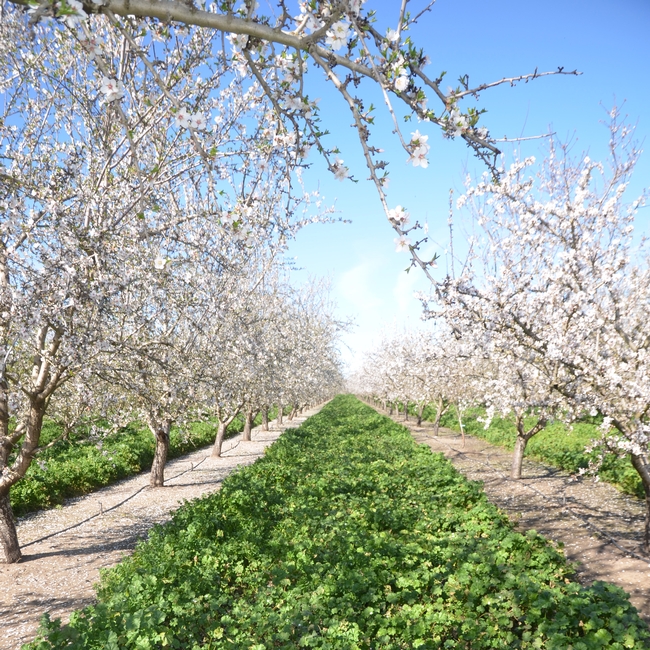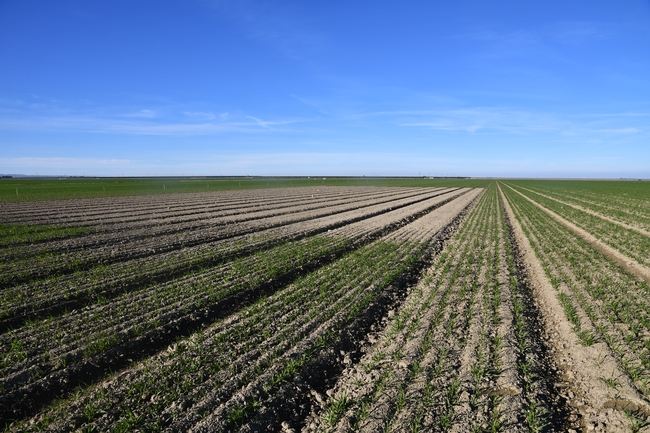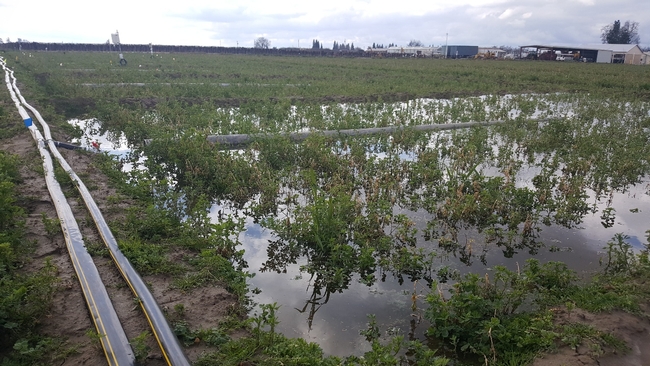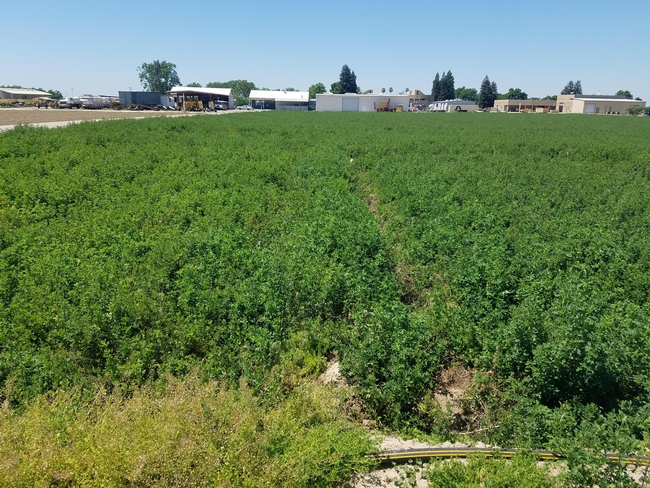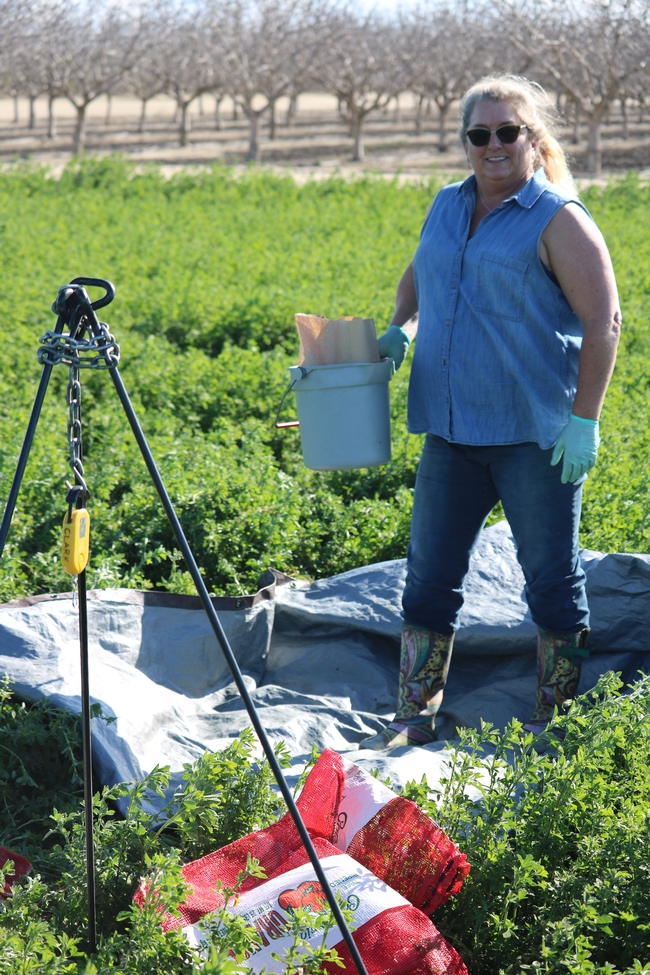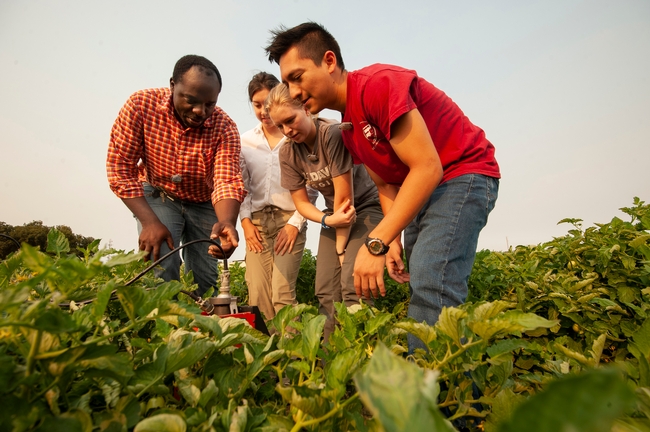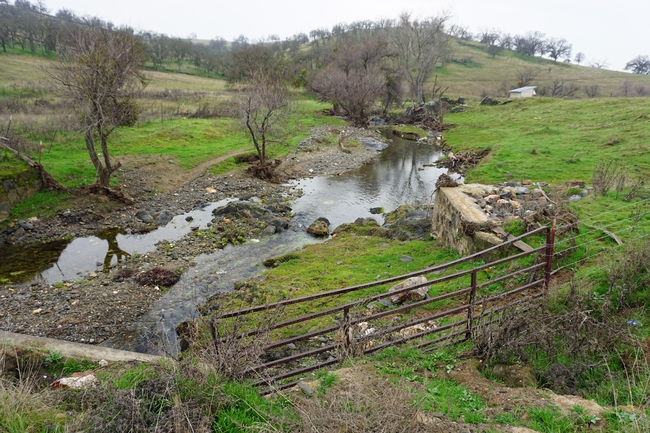Posts Tagged: groundwater
Study offers insights on reducing nitrate contamination from groundwater recharge
Light irrigation before flooding stimulates microbes to remove nitrates from soil
With California enduring record-breaking rain and snow and Gov. Gavin Newsom recently easing restrictions on groundwater recharge, interest in “managed aquifer recharge” has never been higher. This process – by which floodwater is routed to sites such as farm fields so that it percolates into the aquifer – holds great promise as a tool to replenish depleted groundwater stores across the state.
But one concern, in the agricultural context, is how recharge might push nitrates from fertilizer into the groundwater supply. Consumption of well water contaminated with nitrates has been linked to increased risk of cancers, birth defects and other health impacts.
“Many growers want to provide farmland to help recharge groundwater, but they don't want to contribute to nitrate contamination of the groundwater, and they need to know how on-farm recharge practices might affect their crops,” said Matthew Fidelibus, a University of California Cooperative Extension specialist in the UC Davis Department of Viticulture and Enology.
A recently published study by UC scientists sheds new light on how nitrates move through an agricultural recharge site and how growers might reduce potential leaching. Researchers analyzed data from two grapevine vineyards at Kearney Agricultural Research and Extension Center in Fresno County – one flooded for two weeks, and other for four.
Understanding initial nitrate levels crucial
A key factor in mitigating contamination is understanding how much nitrate is in the soil at the outset, said study author Helen Dahlke, a UC Davis hydrologist and leader of UC Agriculture and Natural Resources' strategic initiative on water. In areas with little precipitation and cropping systems that require greater amounts of synthetic fertilizer, the accumulation of residual nitrate – resulting from nitrogen in the fertilizer not taken up by the plants – can be quite high.
“The percentage of nitrates in some soils can really increase over the years, particularly if you have many dry years in a row where you don't have access to irrigation water or natural precipitation flushing some of those nitrates out of the soil,” Dahlke said.
While intense rains in recent weeks have helped dilute nitrate concentrations naturally, farmers looking to participate in recharge during the dry years ahead should consider flooding their fields with greater volumes of water.
“If you're doing this for the first time – on-farm recharge in the winter – check your residual soil nitrate levels because if they're very high, you should apply a lot of water in order to make sure that the residual nitrate is diluted down,” said Dahlke, who also added that growers should check their soil properties for suitability of recharge projects.
She recommended using, as a “good first approximation,” the online Soil Agricultural Groundwater Banking Index map, a project led by Toby O'Geen, a UC Cooperative Extension soil resource specialist.
Researchers looking at other ways to reduce nitrates
Even before flooding the fields for recharge, there are several practices that can lower initial nitrate levels and risk of leaching. Cover crops such as alfalfa and triticale, for example, can help take up residual nitrates that accumulate from fertilizing a main crop over time.
Dahlke and Fidelibus – a co-author of the San Joaquin Valley vineyard study – both pointed to pre-flooding irrigation that encourages denitrification, a process in which soil microbes transform nitrates into gaseous forms of nitrogen.
“Those denitrifying microbes need to be stimulated to do the work,” said Dahlke. “What we have found is that if you do a little bit of irrigation before you start the flooding, increasing the soil moisture can get those microbes started and they can take out more nitrate from the soil.”
The timing and quantity of fertilizer applications are also major factors in reducing leaching. Although more growers are following high-frequency, low-concentration practices to maximize uptake by crops, Dahlke said there needs to be more emphasis on incorporating nitrogen transformation processes – such as denitrification – in the nutrient management guidelines that farmers follow.
“Implementing thoughtful nutrient management plans will play a particularly important role in participating farms,” Fidelibus added.
A more holistic view of groundwater recharge
In short, choices made during the growing season can affect those in the winter recharge season – and vice versa. For example, applying compost or other organic amendments to soil can give microbes the “fuel” they need for sustained denitrification.
“What we have found is that our denitrifying bacteria often run out of steam because they don't have enough carbon to do the work,” Dahlke said. “Like us, microbes need energy to do the work, and for microbes this energy comes from soil carbon.”
Then, adding moisture via recharge to that field with high organic content can stimulate mineralization and nitrification, processes in which microbes transform the organic nitrogen into ammonium – and subsequently nitrates – that the plants can then take up. Those naturally occurring nitrates would thus reduce the need for the grower to apply synthetic fertilizer.
“The winter on-farm recharge experiments have shown that altering the moisture regime in the winter has consequences for the nitrogen budget in the summer growing season,” Dahlke explained. “Theoretically, what we need to be doing is better integrating both seasons by keeping an eye on the soil-nitrogen balance across the whole year so that we can ensure, at the end of the growing season, the residual nitrate in the soil is minimized.”
The study, published in the journal Science of The Total Environment, was part of the post-doctoral work of former UC Davis researcher Elad Levintal. In addition to Fidelibus and Dahlke, other authors are Laibin Huang, Cristina Prieto García, Adolfo Coyotl, William Horwath and Jorge Rodrigues, all in the Department of Land, Air and Water Resources at UC Davis.
New cover crop research can help groundwater sustainability agencies plan
Cover crops seem to offset their water use by improving soil moisture retention
Cover crop research conducted by a team of university researchers is now helping to inform and shape policy to implement the Sustainable Groundwater Management Act (SGMA) in several San Joaquin Valley counties.
“The Madera County Regional Water Management Group appreciates continued scientific discussions on SGMA-related issues, and especially enjoyed hearing from researchers on cover crops,” said Tom Wheeler, chair of the Regional Water Management Group for Madera County and a Madera County supervisor. “This is work that should be helpful to growers as they evaluate cover crops as part of their sustainable future.”
To help protect groundwater resources over the long-term, groundwater sustainability agencies (GSAs) are developing groundwater sustainability plans for their local regions.
"Our findings suggest that cover crop water use is negligible in most water years and the long-term benefits can help GSAs meet their management goals,” said Alyssa DeVincentis, a former UC Davis Ph.D. student who worked on the project. “How cover crops impact soil moisture depends on species and management history, but generally soil moisture at the end of the winter season did not differ between fields with winter cover crops and clean cultivated soils."
From 2016 through 2019, UC Agriculture and Natural Resources researchers and their collaborators amassed very large data sets from almond orchard and tomato field sites located between Chico in Butte County and Arvin in Kern County. They used the data to quantify changes in soil water storage and evapotranspiration that occur under cover-cropped and bare fallow conditions during the winter cover crop growing period – about November to March.
The research team includes UC Cooperative Extension water specialists Daniele Zaccaria, Samuel Sandoval-Solis and Jeff Mitchell based at UC Davis; DeVincentis now of Vitidore, Inc.; and Anna Gomes, Ph.D. student at Stanford University.
The GSAs must first quantify the amount of water going into the groundwater bank through rainfall and surface water irrigation versus the amount of groundwater being removed at all farms within the GSA's jurisdiction.
“To do this, many local GSAs are turning to remote sensing and modeling of evapotranspiration, or ET, to provide data on the regional balance between groundwater depletions versus recharges,” Mitchell explained.
“Because winter cover crops may appear on remote sensing images as water-using vegetation, the sole use of model-driven data coming from satellites could become a disincentive to the practice being used.”
“This approach may not account for the important benefits that winter cover crops provide San Joaquin Valley farmers like Justin Wylie, a Madera County almond and pistachio grower who works with the research team,” Mitchell said. “He has experienced the benefits of winter cover crops firsthand, including increased water infiltration, habitat and carbon for soil organisms, and reduced water run-off.”
Cover crops grown during the winter may not use a lot of soil water because ET during this period tends to be low. They also provide shading and soil surface cooling, which help reduce soil evaporation. In addition, Mitchell said that cover crops can improve soil aggregation, pore space and soil moisture retention.
Together, cover crop benefits seem to offset or compensate for their actual water use during the winter.
“Because GSAs need reliable and accurate information related to this important issue and to possible shortcomings of relying solely on remote sensing as the way to go, our research has been particularly timely in the context of SGMA,” said Daniele Zaccaria, associate professor and water management specialist in UC Cooperative Extension at UC Davis.
A presentation about their cover crops research is available on YouTube at https://youtu.be/x3xQlZ9EdCk. The webinar is intended for water agency personnel, but the information is relevant to anyone who is interested in how cover crops may influence San Joaquin Valley cropping systems and the water cycle, Mitchell said.
A peer-reviewed article about this cover crop research, “ “Impacts of winter cover cropping on soil moisture and evapotranspiration in California's specialty crop fields may be minimal during winter months,” will appear in the first quarterly issue of California Agriculture in 2022.
California groundwater could get recharging help from alfalfa farms
When California experiences drought due to a lack of rain and snow and the reservoirs don't fill up, people pump water out of the ground to meet their needs. But that practice has its limits, as groundwater aquifers -- underground layers of porous rock -- get depleted, similar to how water squeezes from a sponge.
Many of California's groundwater aquifers, especially in the San Joaquin Valley, are critically overdrafted. They are being depleted faster than they are being recharged by water from the surface percolating through the soil to groundwater. Overdrafting is a concern because California relies on groundwater aquifers as a water storage and supply resource. They must be protected to ensure water security in the future.
To direct surface water back into the aquifers, recharge basins are built, but they are limited in number and volume. Thinking of agricultural fields as potential recharge basins opens the possibility of increasing the number of locations where groundwater aquifers can be recharged.
Alfalfa is a crop that has a unique potential to support this practice because it is widely grown in the San Joaquin Valley and, in many cases, the plants are dormant or semi-dormant during the winter months. University of California researchers Helen Dahlke, Nick Clark and Khaled Bali are investigating how alfalfa copes with additional water in the winter and early spring, when snowmelt runoff occurs, for groundwater recharge.
“We hypothesized that water can be recharged in dormant and early regrowing established alfalfa fields successfully, and with little to no harm to the plants and the productivity as far as the farmer is concerned,” said Clark, a UC Cooperative Extension farm advisor.
The findings have shown great promise for recharging groundwater without negatively impacting alfalfa yield but may diminish quality. “You could do recharge in winter and then turn the water off completely and still get a cutting or two of alfalfa before the summer,” said Bali, a UCCE irrigation water management specialist.
Like Bali, Clark thinks alfalfa growers could use their fields for recharging groundwater while taking steps to limit loss of crop value.
“We did find that the practice of recharging groundwater in alfalfa fields can have a negative impact on the feed quality of the alfalfa when first harvested after the flooding,” Clark said.
“One big recommendation we have is that the alfalfa fields should be in their later years of production so if something disastrous happens, there is not so huge of investment return lost,” said Clark. “There is current research being conducted by UC Cooperative Extension specialists Dan Putnam and Khaled Bali examining practical solutions on the farm level that growers can implement to minimize the risk of damage to alfalfa when also flooding fields for groundwater recharge.”
Clark emphasized that farmers face incredibly complex water-management issues today. The drivers that influence their decisions reach far beyond the farm, so he collaborates with UC Davis professor Helen Dahlke, who studies integrated hydrologic sciences.
“It requires an approach from multiple disciplines to address that complexity,” he said. “Helen brings hydrological expertise, while I can focus on agronomy. So the information we provide is more holistic and relevant on a larger scale, but still practical and applicable for farmers.”
Grower input on the research findings has been critical to their success. “With their feedback, we were able to reform some of the project methodologies to achieve results that were even more relevant to the local conditions,” said Clark.
With the prolonged drought, innovations in groundwater recharge are becoming more crucial. Future research will continue to focus on how growers can use their land in multifaceted ways to improve California's water sustainability far into the future.
UC Davis to lead groundwater and irrigated agriculture sustainability study
Effort Will Develop Ways to Minimize Risk from Climate Extremes for Southwest Growers
Researchers from the University of California, Davis, have been awarded a $10 million grant by the U.S. Department of Agriculture's National Institute of Food and Agriculture to find ways to sustain irrigated agriculture while improving groundwater quantity and quality in the Southwest under a changing climate.
Isaya Kisekka, associate professor of agrohydrology and irrigation at UC Davis, is leading a team of more than two dozen climate, plant and soil scientists; hydrologists; engineers; economists, educators and extension specialists from UC Davis and other institutions in California, Arizona and New Mexico. They will develop climate change adaptation management strategies that ensure sustainability of groundwater and irrigated agriculture.
Kisekka says the project team in California will work with Groundwater Sustainability Agencies to develop tools and data to enhance water management at both the farm and groundwater basin scales to improve crop production and achieve sustainability goals under the state's Sustainable Groundwater Management Act, which provides a statewide framework to help protect groundwater resources over the long-term. The research team will also work with grower coalitions to achieve the groundwater quality goals of the Central Valley Salt and Nitrate Management Plan.
“For farmers, the biggest challenge threatening their business is water,” Kisekka said. “Our project is going to develop climate-smart adaptation management practices to help growers achieve their production goals while addressing the co-benefits for the environment and human health. We are going to develop cutting edge tools to manage groundwater quantity and quality as well as study how policies impact behaviors such as water use in agriculture.”
The practices, models and tools developed will be used by growers or their advisors, policymakers, irrigation districts, coalitions and groundwater sustainability agencies to address climate change extremes such as drought or floods.
Growing dependence on groundwater
Growers have increasingly depended on groundwater during multi-year droughts and heat stress. Part of the five-year project includes looking into aquifer systems in California's Central Valley, central Arizona and the lower Rio Grande basin in New Mexico. These regions have all experienced unprecedented overdraft, which happens when more water is pumped from a groundwater basin than is replaced from sources, including rainfall.
“For a long time, a lot of farmers would use groundwater as an insurance policy whenever there was a drought,” Kisekka said. “The negative consequences of that became obvious: groundwater levels declined, we had subsidence which causes land to sink, we had deterioration in water quality and so on. What are growers going to do when we have another drought like we are now? We have to think more broadly.”
Kisekka says they will also come up with management practices to improve soil health, develop alternative water supplies and reduce water demand so the region can continue to produce various agriculture commodities, such as vegetables, grapes and almonds.
“We grow crops in California that we cannot shift to another part of the country because they won't grow well there,” Kisekka said. “We can't grow almonds in the Southeast where they have a lot of water because they require a certain climate. We want to ensure food and nutritional security of the United States by sustaining irrigated agriculture in the Southwest.”
Project researchers will also establish innovative education and extension programs to teach students of all backgrounds and ages, as well as the public, about the importance of water in agriculture.
“Part of this is to develop educational curriculums from elementary to high school to college, where instructors can pull our modules on water management or sustainable agricultural systems and teach that in their classes,” Kisekka said.
While the depletion of groundwater supplies, among other factors, puts major pressure on agricultural operations in the southwestern region, Kisekka hopes the management practices and tools that will be developed during this project will help improve production and resource sustainability and help make California and the country more resilient to climate change. UC Davis will establish the Agricultural Water Center of Excellence as part of the grant. This unique Center of Excellence will also have capacity to support agricultural water research, education and extension activities at collaborating institutions with potential impact at local, state, national and international levels.
“We hope at the end of the day we can still grow food in California and the Southwest in general without drying out our groundwater aquifers,” he said. “We have to learn to adapt to climate change. We may not be able to stop it in the short term, but we should be able to adapt.”
Researchers from University of California, Berkeley, UC Agriculture and Natural Resources, Stanford University, CSU Fresno, University of Arizona, New Mexico State University, USDA Agricultural Research Service (Sustainable Agricultural Water Systems Research: Davis, CA and Water Management and Conservation Research: Maricopa, AZ) and USDA Climate Hub are also participating in the project.
There’s a danger in over-simplifying California water conservation
You hear it every time drought returns to California: “Turn off the faucet when you brush your teeth.” “Collect shower water in a bucket before it warms up.”
While valuable, these tried and true drought resilience strategies can also deflect attention from the monumental challenges posed by droughts to natural areas, waterways, agriculture and people in California. Far-sighted and discerning management of the state's annual precipitation and groundwater is critical, particularly as droughts become more frequent due to climate change, said Faith Kearns, the academic coordinator of UC's California Institute for Water Resources.
“Like so many big societal problems, we don't want to get caught up believing individual actions alone will solve this problem,” Kearns said. “Conserving water in households can help people feel activated and certainly conserve some water. But, at the same time, it's not enough. We have big, systemic issues to deal with.”
Urban water use in homes, landscapes, schools and businesses amounts to about 10% of total developed water use in California, according to the Northern California Water Association. Irrigated agriculture uses 41%. The remaining 51% is used for water in rivers protected by state and federal laws as “wild and scenic,” water required for maintaining habitat in streams, and water that supports wetlands in wildlife preserves.
Traditionally, when surface water supplies for California farmers are cut during droughts, farmers pumped groundwater to bridge the gap. Over time, many of the state's groundwater basins have become severely depleted. In 2014, during a devastating five-year drought, the California Legislature passed the Sustainable Groundwater Management Act to regulate groundwater use in the state for the first time. The law aims for sustainable groundwater maintenance by 2040.
“We're in the implementation phase and local groundwater agencies are in various stages of developing and implementing sustainability plans,” Kearns said. “This is an opportunity for public participation to ensure all voices are heard in the effort.”
Of particular concern are underserved rural families who rely on wells for their household water. When the water table drops due to excessive pumping, the families can be left without water for drinking, washing and bathing. Small scale farmers often meet the same fate. Larger, neighboring farms may be able to drill deeper wells.
Wintertime flooding in permeable areas is one way groundwater can be recharged as it is used during the dry season. Getting access to water, developing infrastructure and flooding large farms will allow water to seep back into aquifers. Small-scale farmers can also be involved, said Ruth Dahlquist-Willard, the UC Cooperative Extension advisor to small-scale farmers in Fresno and Tulare counties.
“If there was a way to incentivize recharge on small farms, I think we could really contribute to groundwater management,” Dahlquist-Willard said. “It is not just about how we protect small farmers but also about how we involve them and have something that works for everyone's benefit.”
Fallowing land will likely be needed to meet the groundwater law's sustainability requirements. A 2020 report by UCCE specialist David Sunding and UC Berkeley professor David Roland-Holst, Blueprint Economic Analysis: Phase One Results, estimates about 992,000 acres of California farmland will go out of production, representing $7 billion in lost crop revenue and $2 billion in lost farm operating income.
The public can support smart and equitable water management by learning about decisions being made by their own local water providers and elected government representatives that impact the future of the California water supply. UC Agriculture and Natural Resources and its California Institute of Water Resources have gathered materials to serve as a starting point for understanding and advocating for sustainable water.
Science-based drought tipsheets
Online drought and water management seminar series
Listen to these episodes of the Water Talk podcast:
Episode 02: Ranching and Water in California — Water Talk
Episode 09: Small Farms and Water in California — Water Talk
Episode 10: California Water Policy and Extension — Water Talk
Episode 15: Wild Horses and Water in California — Water Talk
Episode 16: Agriculture in the California Borderlands — Water Talk
Episode 21: Watering Urban Green Spaces — Water Talk
Find more on the UC California Institute for Water Resources website.


